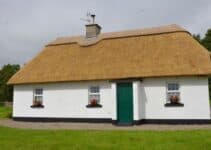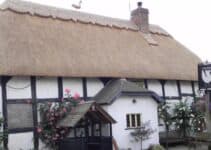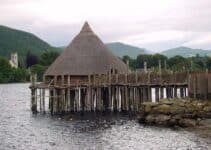Imagine the idyllic charm of traditional roof architecture, perhaps in a rural village where homes are crowned with the distinct silhouette of thatched roof designs. Now, visualise this pastoral elegance extended with a catslide roof extension — an architectural feature that whispers tales from the past while providing a practical solution for modern living. The catslide, as you might guess, borrows its name from the graceful descent a cat makes as it slides off a roof, and this historic element is an enduring symbol of classic British and New England craftsmanship. Whether you’re a homeowner seeking to capture the quintessence of heritage or an enthusiast of architectural nuances, exploring the world of catslides on thatched roofs opens a window to a tradition that beautifully marries utility with time-honoured aesthetics.
Understanding the Basics of Catslides
When considering roof construction, the term ‘catslide’ may surface, alluding to a specific roof design celebrated for its aesthetics and practicality. Catslides are distinguished by an overhanging roof section that extends significantly downwards from the main roof pitch, offering a harmonious fusion of form and function.
This ingenious extension technique, integral to the catslide roof design, enables the expansion of the interior space without altering the ridge height, thus maintaining the overall proportion and symmetry of the building facade. Furthermore, it cleverly allows for a lean-to extension at the rear of the structure, often without the need for complex structural alterations.
| Feature | Functional Benefit | Aesthetic Impact |
|---|---|---|
| Extended Overhang | Increases depth of building; does not raise the ridge height | Enhances architectural character; preserves original roofline |
| Lower than Eaves | Facilitates additional sheltered space | Creates a visually pleasing gradual descent of the roofline |
| Extension Adaptability | Allows for versatile use as porches or additional rooms | Seamlessly blends with existing structure, enhancing continuity |
Catslides are commonly encountered in historic properties, where they serve as practical extensions whilst respecting the building’s traditional architecture. Importantly, such features are historically linked to thatched homes and barns, where the roof construction required materials and methods sympathetic to the original craft.
Embracing a catslide design in a modern lean-to extension comes with its set of considerations. You should weigh up not just the structural implications, but also the roofing materials and the impact on the external appearance. Nonetheless, the essence of a catslide remains the same, to extend gracefully while keeping true to the architectural heritage.
The Historical Significance of Catslide Roofing
The architectural tapestry of the United Kingdom and the broader Atlantic realm is rich with narratives that speak of historical development and cultural exchanges, symbolised through unique design elements like the catslide roof. In this section, we delve into the origins of this distinctive feature and its place in the chronicles of historic roofing and architecture.
The Origins and Evolution of Catslides
Catslide roofing arises from the ingenuity of medieval craftsmanship, a testament to the era’s roofing heritage that continues to characterise the landscapes of heritage sites. Originating from a period where resources were often limited, the practicality of extending a habitation without the need for elaborate construction made the catslide an ingenious solution. When you observe the sweeping descent of these roofs, consider the possibility that the inspiration sprung from the graceful motion of a cat navigating the perils of a steep roof.
Representation in British and American Architecture
The cross-pollination of architectural styles between the UK and the USA has resulted in unique iterations of medieval architecture, with the transatlantic architectural influence evident in the catslides found in New England homes. British colonial architecture, with its adaptive strategies, took on a new form as it met with the demands of the American climate and available materials. The cedar shingles of New England are a tribute to this adaptability, proposing a different aesthetic from the thatched varieties more common in the old country, yet still preserving the essential functionality of the design.
| Feature | Medieval British Catslides | New England Catslides |
|---|---|---|
| Materials | Thatch, Timber | Cedar Shingles |
| Structure | Extended Timber Frames | Two-storey Houses with Back Extensions |
| Function | Expand Living Space Cost-Effectively | Cover Extensions and Improve Drainage |
| Cultural Symbolism | Medieval English Vernacular Architecture | Adapted Colonial Architecture with British Origins |
Understanding the historical significance of catslide roofing allows you to appreciate the depth of heritage embedded in the structures that have shaped both the British and the American landscapes. These roofs do more than shelter; they narrate stories of time, culture, and architectural evolution. It’s worth noting that with every glance at a building adorned with this historic roofing style, you’re essentially looking at a page turned from the book of medieval architecture, unfurled across the centuries to rest upon both humble cottages and stately homes, leaving an indelible mark of a bygone era on our modern skylines.
Architectural Features of Catslides on Thatched Roofs
When considering the thatched roof features of a property, the architectural flair provided by a catslide cannot be overstated. This particular roofing style has stood the test of time, not merely as a decorative element but for the practical benefits it bestows upon a timber frame extension. Recognisable for its seamless integration with the existing thatch, a catslide is a testament to the ingenious design elements inherent in traditional craftsmanship.
The pitch of a catslide roof is often adjusted to merge smoothly with the thatched roof’s contours, thereby enhancing the dwelling’s visual and structural harmony. Not only does it augment the aesthetic value of the property, but it also increases the usable space within, without compromising the building’s historical appearance.
| Feature | Description | Benefits |
|---|---|---|
| Extended Pitch | The pitch is modified to cover the additional space created by the extension. | Enhances the property’s silhouette and provides additional living space. |
| Seamless Design | Aesthetically blends with the main roof using matching thatch materials. | Retains the historic character of the property while modernising. |
| Practicality | Serves as an architectural solution for adding space without extensive reconstruction. | Cost-effective extension to a home’s living quarters. |
As you consider embracing the rustic charm of thatched roofing for your property, it is essential to appreciate how the architectural features of a catslide can accentuate the overall design. It is this unique blend of functionality and style that makes such an extension a desirable attribute in a heritage property.
Comparing Thatched Catslides and Modern Alternatives
The allure of traditional thatched roofing has long embraced the unique catslide, a feature enriched with history and bearing the stamp of roofing craftsmanship. These natural thatching methods wield heritage building materials to cultivate an aesthetic synonymous with bucolic charm. Amidst evolving technologies, a juxtaposition surfaces against modern, synthetic alternatives, inviting a meticulous comparison to discern which materials best marry tradition with contemporary living.
Traditional Thatching Materials and Techniques
Embracing the number 6 as more than a digit, traditional thatched roofs evoke a sense of nostalgia, using time-honoured methods and materials such as African Yellow Grass or the classic European style thatching. These materials are not simply components of construction; they are threads woven into the fabric of historical architecture, meticulously crafted by artisans whose skills have been honed over generations.
Synthetic Thatch Roofing Options
Conversely, the advent of synthetic thatch has introduced a myriad of options for homeowners. Materials such as the trimmed Capetown, the textured Kilimanjaro, and the tropical-look Kona offer durability without neglecting the stylistic elements that thatch enthusiasts seek. The synthetic alternatives, like the palm leaf imitating Dominica or the East Asian-inspired Bali, provide a durable solution that maintains the charm of traditional thatching. For those on a budget, the Viva Series offers an economical yet appealing choice. Each of these materials is contributing to a versatile marketplace that allows the continuation of thatched roofing into an era of robust, low-maintenance alternatives.
The Aesthetic Appeal of Catslides in Cottage Design
When you envisage a traditional cottage, a picture of quaint architecture with characterful thatched roofing likely springs to mind. It’s the catslide roof, however, that can unify charm with utility, enhancing the cottage’s silhouette whilst accommodating architectural expansion. This clever design masterstroke respects the integrity of the building, playing a pivotal role in the overall roof aesthetics. Not only do catslides preserve the characterful ambience found in the rolling dales of the English countryside, but they also adapt seamlessly to the modern needs for additional space within the structure’s original footprint.
Incorporating Catslides into Cottage Aesthetics
Cottage roofing isn’t solely about protection from the elements; it’s a statement of style and historical relevance. Incorporating a catslide into your cottage’s architecture warrants a design that is thoughtful and steeped in tradition. With your keen interest in architectural design, you’ll recognise the importance of maintaining the visual appeal of a cottage, whilst subtly enhancing the property’s functionality. The catslide isn’t just architecturally satisfying, it’s an embodiment of how buildings can evolve without losing their historical essence.
Catslides’ Contribution to Property Values
The allure of owning a property adorned with unique architectural features, such as a catslide, can significantly heighten real estate value. It’s not merely an investment in a property; it’s an investment in a slice of heritage that continues to tell a story. For buyers and investors, the promise of owning a home with such distinctive characteristics can be a marker of a sound property investment. Whether you’re looking to preserve the past or plan for the future, the addition of a catslide is bound to be a topic of admiration, a conversation starter that might ultimately lead to a profitable venture in the property market.



